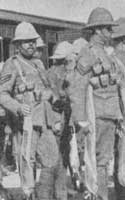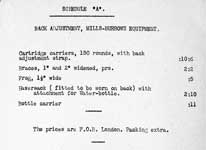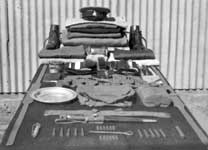Back Adjustment, Mills-Burrows Equipment with the Union Defence Force
 A recent discovery by the Karkee Web Research Team has revealed a surprising new fact. Canada was not, as collectors have long believed, the only country to adopt Web Equipment, Pattern 1913. The photo at left shows the 1st South African Mounted Rifles on parade. In the un-cropped photograph (just click on the thumbnail), you can see the distinctive profile of Table Mountain, Cape Town, in the background. The un-mistakable "two over three" symmetrical Patt. '13 Cartridge carriers are readily visible, as are the reduction weave Braces, making the identification as W.E. Patt. '13 a certainty. Further investigation has uncovered a number of other photographs, apparently from the same series, showing the 1st S.A.M.R. in W.E. Patt. '13, embarking for German South-West Africa. Some of these were reproduced in a recent book on the Boer War, where they were mislabeled as photos from that earlier conflict.
A recent discovery by the Karkee Web Research Team has revealed a surprising new fact. Canada was not, as collectors have long believed, the only country to adopt Web Equipment, Pattern 1913. The photo at left shows the 1st South African Mounted Rifles on parade. In the un-cropped photograph (just click on the thumbnail), you can see the distinctive profile of Table Mountain, Cape Town, in the background. The un-mistakable "two over three" symmetrical Patt. '13 Cartridge carriers are readily visible, as are the reduction weave Braces, making the identification as W.E. Patt. '13 a certainty. Further investigation has uncovered a number of other photographs, apparently from the same series, showing the 1st S.A.M.R. in W.E. Patt. '13, embarking for German South-West Africa. Some of these were reproduced in a recent book on the Boer War, where they were mislabeled as photos from that earlier conflict.
The discovery of South Africa's use of Web Equipment, Pattern 1913, follows the recent news, also first reported on Karkee Web, that South Africa was also the first country to adopt Web Equipment, Pattern 1925 (see the Patt. '25 page). Couple these finds with the well know fact that South Africa, in 1934, was the only country to adopt the Braithwaite Committee’s "No. 3 Pattern" Web Equipment, and an interesting picture emerges. South Africa seems to have had a predilection for adopting the very latest in Mills Web Equipment, at least for its elite units. The organization of the Union Defence Force facilitated this more readily, having only a small Permanent Force, the remaining units forming the Active Citizen Force, equating to the U.K.’s Territorial Force. The latter units were far less well accoutred! More research is underway, in the hopes of finding more detail on what promises to be a very interesting story.
 Information has now come to light, regarding the use by S.A.M.R. and Karkee Web is indebted to Peter J. Smith’s researches for this additional information. The Union Defence Force was established by the South African Defence Act of 1912 and its H.Q. was established on 1st July 1912. The U.D.F. would comprise a Permanent Force and an Active Citizen Force. The former would have a Coast Garrison Force and five regiments of Mounted Infantry, to be named 1st – 5th South African Mounted Rifles. The prospective Colonels of the new Regiments met in October 1912 to discuss what accoutrements should be adopted. They had before them a Schedule “A” from the Mills Equipment Company, which detailed the components and prices of “Back Adjustment, Mills-Burrows Equipment”, in other words Patt. 1913 W.E.. Burrowes’ name was spelled incorrectly here, though the correct spelling was used elsewhere. Their recommendation was accepted and, when the Permanent Force was established in 1913, the S.A.M.R. were issued with the new web pattern.
Information has now come to light, regarding the use by S.A.M.R. and Karkee Web is indebted to Peter J. Smith’s researches for this additional information. The Union Defence Force was established by the South African Defence Act of 1912 and its H.Q. was established on 1st July 1912. The U.D.F. would comprise a Permanent Force and an Active Citizen Force. The former would have a Coast Garrison Force and five regiments of Mounted Infantry, to be named 1st – 5th South African Mounted Rifles. The prospective Colonels of the new Regiments met in October 1912 to discuss what accoutrements should be adopted. They had before them a Schedule “A” from the Mills Equipment Company, which detailed the components and prices of “Back Adjustment, Mills-Burrows Equipment”, in other words Patt. 1913 W.E.. Burrowes’ name was spelled incorrectly here, though the correct spelling was used elsewhere. Their recommendation was accepted and, when the Permanent Force was established in 1913, the S.A.M.R. were issued with the new web pattern.
The date of 1912 might have merited a “Pattern 1912 W.E.” nomenclature. More probably it was the Schedule “A” nomenclature, which was Mills’ own internal nomenclature. A 1944 document, which does not include Patt. ’13, reveals a varied approach to Union Defence Force nomenclature, with Patt. ’08 W.E. rendered (curiously in alpha-numeric) as “Web Equipment, Pattern O.8” (Oh-dot-eight, not zero-eight) and No. 3 W.E. as “ Web Equipment, Braithwaite”, though Patt. ’37 W.E. was rendered as “Web Equipment, Pattern 37” - but with no apostrophe in front of “37”1.

 Being Mounted Infantry, they did not adopt the Patt. ’13 Pack, its contents being distributed on their saddlery, which was normal practice for cavalry. The Haversack was intended for wear on the back, not at the side and “…with attachment for Water bottle…”. This was the original form provisioned with Patt. ’08 W.E., but with the benefit of hindsight, locating a water bottle so in-accessibly was short-sighted – especially in Africa. To reach the bottle, the whole set had to be removed, unless somebody else did it for the wearer. Doubtless, Mills felt the design was novel and de-cluttered the legs - one of its Unique Selling Points, to use the modern term. The S.A.M.R. were shortly to discover this shortcoming, during their campaign in the arid conditions of German South-West Africa. In addition, a Frog, qualified as “…1 ½ “ wide…” was included. Being narrower than the Patt. ’08 version, a hilt loop was added, to prevent the bayonet swinging. From 1913-1926, the S.A.M.R. were equipped with Charger Loading Lee Enfields – the “Long L.E.”, so the Frog carried a Patt. 1888 Bayonet. The S.A.M.R. kit layout at left has been submitted by KWRT member Peter J. Smith, who also discovered Schedule “A”. The Haversack is clearly shown, but with no Pack.
Being Mounted Infantry, they did not adopt the Patt. ’13 Pack, its contents being distributed on their saddlery, which was normal practice for cavalry. The Haversack was intended for wear on the back, not at the side and “…with attachment for Water bottle…”. This was the original form provisioned with Patt. ’08 W.E., but with the benefit of hindsight, locating a water bottle so in-accessibly was short-sighted – especially in Africa. To reach the bottle, the whole set had to be removed, unless somebody else did it for the wearer. Doubtless, Mills felt the design was novel and de-cluttered the legs - one of its Unique Selling Points, to use the modern term. The S.A.M.R. were shortly to discover this shortcoming, during their campaign in the arid conditions of German South-West Africa. In addition, a Frog, qualified as “…1 ½ “ wide…” was included. Being narrower than the Patt. ’08 version, a hilt loop was added, to prevent the bayonet swinging. From 1913-1926, the S.A.M.R. were equipped with Charger Loading Lee Enfields – the “Long L.E.”, so the Frog carried a Patt. 1888 Bayonet. The S.A.M.R. kit layout at left has been submitted by KWRT member Peter J. Smith, who also discovered Schedule “A”. The Haversack is clearly shown, but with no Pack.
A photo noted by M.C. Heunis is shown at right above. This is another in the sequence showing the S.A.M.R. embarking for the campaign in German South West Africa. It clearly shows the Haversack being worn on the back, though the Water bottle carrier is on the Brace ends. Perhaps Mills’ U.S.P. had already been found wanting?
Footnotes:
1. Form D.D. 409 S.A. Permanent Force Arms and Accoutrements. A form, batch printed in 1944, does not list Patt. ’13, but gives these variations from U.K. nomenclature